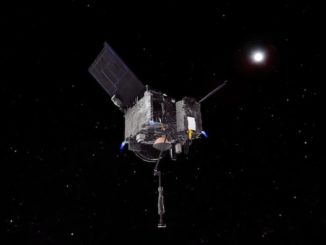
NASA is advancing a plan to send a robotic orbiter to Mars in the early 2020s, developing designs with five U.S. satellite makers for a mission to extend high-resolution mapping capabilities, telecommunications relay functions, and potentially act as a waypoint for Martian soil samples destined for return to Earth.
The orbiter could launch as soon as late 2022, when Mars and Earth are in the correct positions to make a direct journey possible. Mars launch opportunities come every 26 months.
The mission, projected to cost between $500 million and $1 billion, would be NASA’s first Mars orbiter since the MAVEN atmospheric research craft launched in November 2013.
NASA signed contracts with five U.S. companies earlier this month to conduct concept studies for the next-generation orbiter. Officials have said the agency will likely purchase the orbiter from a commercial supplier, similar to the way NASA outsourced development of the Mars Reconnaissance Orbiter to Lockheed Martin.
MRO was the last orbiter developed fully under the umbrella of NASA’s Mars program. MAVEN was selected through a science competition, and the project is led by its chief scientist.
The multi-purpose orbiter will primarily replace the aging MRO, which arrived at Mars in early 2006 and has outlived its design lifetime.
The companies awarded four-month Mars orbiter study contracts are Boeing, Lockheed Martin, Northrop Grumman, Orbital ATK and Space Systems/Loral.
Jim Watzin, head of NASA’s Mars exploration program, said last month that the new orbiter’s main mission will be relaying communications between Earth and rovers on the Martian surface. The relay capability drastically increases the amount of science data, images and other information transmitted back to ground controllers.
It will also likely carry a camera with vision at least as good as the HiRISE telescope currently aboard MRO, giving scientists sharp views of the Martian landscape and helping map landing zones for future robots, and eventually humans.
“We’re still working through what the mission content will be,” Watzin said.
A group of scientists tasked with setting possible goals for the next-generation orbiter concluded that the mission should also locate resources such as water that could be helpful for future astronaut excursions on the Martian surface. The mission could also make strides toward a planned Mars Sample Return project, a top priority for NASA’s planetary science division.
The planning team’s report also laid out three possible mission scenarios.
One of the concepts, at the lower end of the cost and complexity spectrum, could be a one-for-one replacement for MRO. More advanced options could incorporate solar-electric propulsion and optical communications, two technologies NASA says it must develop and demonstrate before sending people into deep space.
Using a noble gas and electrical power to produce thrust, a solar-electric propulsion system could allow the new Mars orbiter to more readily change its orbit. Such a capability would be useful to rendezvous with a launch vehicle that could blast off from Mars with samples tagged to return to Earth.
NASA’s Mars 2020 rover will collect the specimens and deposit them in tubes on the Martian surface for retrieval by a later fetch mission.
Officials have made no decisions on whether the next Mars orbiter might play a direct role in the Mars Sample Return process, which will require multiple missions, starting with the 2020 rover.
An optical communications unit aboard the next Mars orbiter would return orders of magnitude more data to Earth, perhaps even video clips. That capability has both scientific benefits and feeds into planning for human voyages to Mars, officials said.
The five companies awarded study contracts earlier this month will look into how their spacecraft designs could accommodate the highest-priority high-resolution imaging and telecom relay objectives set out by NASA.
“They also will assess the possibilities for supporting additional scientific instruments and functionalities, in addition to optical communications,” NASA said in a statement. “The orbiter concept under study would take advantage of U.S. industry’s technology capacities by using solar-electric propulsion to provide flexible launch, mission and orbit capabilities.”
Email the author.
Follow Stephen Clark on Twitter: @StephenClark1.



